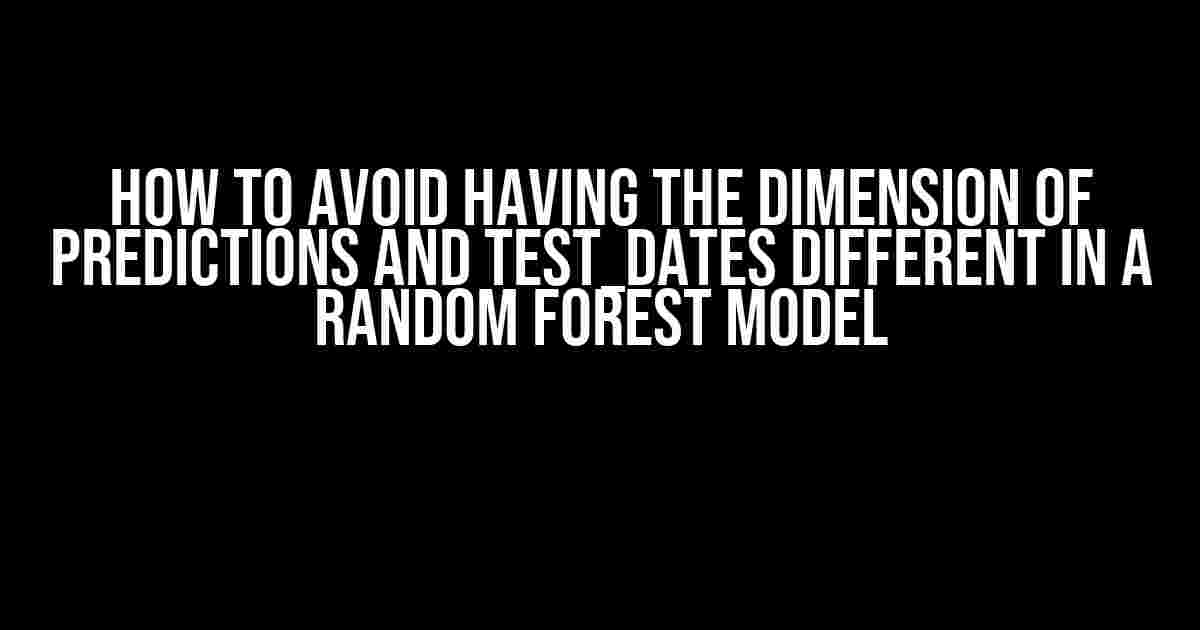Are you tired of struggling with inconsistent dimensions in your random forest model predictions and test dates? Do you find yourself constantly tweaking your code, only to end up with frustrating errors? Well, worry no more! In this article, we’ll delve into the world of random forest modeling and provide you with a step-by-step guide on how to avoid having the dimension of predictions and test_dates different.
Understanding the Problem
Before we dive into the solution, it’s essential to understand why this problem occurs in the first place. When working with random forest models, you’re likely to encounter the following scenarios:
- Unequal lengths of predictions and test_dates arrays: This occurs when the number of predictions generated by your model doesn’t match the number of test dates you’re trying to compare them with.
- Inconsistent indexing: When the indexing of your predictions and test_dates arrays doesn’t align, it can lead to mismatched comparisons and incorrect results.
These issues can be attributed to a range of factors, including:
- Incorrectly formatted data
- Missaligned indexing
- Model configuration errors
The Solution
Now that we’ve identified the problem, let’s explore the solution. To avoid having the dimension of predictions and test_dates different in a random forest model, follow these steps:
Step 1: Preprocess Your Data
Before training your model, ensure that your data is properly formatted and indexed. This includes:
- Verifying that your target variable and feature columns have the same length
- Checking for any missing values and handling them appropriately
- Encoding categorical variables correctly
import pandas as pd
# Load your data
data = pd.read_csv('your_data.csv')
# Verify target variable and feature columns have the same length
assert len(data.target) == len(data.drop('target', axis=1))
# Handle missing values
data.fillna(data.mean(), inplace=True)
# Encode categorical variables
from sklearn.preprocessing import LabelEncoder
le = LabelEncoder()
data['category'] = le.fit_transform(data['category'])
Step 2: Split Your Data
Split your preprocessed data into training and testing sets. This will enable you to evaluate your model’s performance and avoid overfitting:
from sklearn.model_selection import train_test_split
X = data.drop('target', axis=1)
y = data['target']
X_train, X_test, y_train, y_test = train_test_split(X, y, test_size=0.2, random_state=42)
Step 3: Train Your Random Forest Model
Train your random forest model using the training data:
from sklearn.ensemble import RandomForestClassifier
rf_model = RandomForestClassifier(n_estimators=100, random_state=42)
rf_model.fit(X_train, y_train)
Step 4: Generate Predictions
Use your trained model to generate predictions on the testing data:
y_pred = rf_model.predict(X_test)
Step 5: Align Your Predictions and test_dates
Now, it’s essential to align your predictions and test_dates arrays. You can do this by using the same indexing for both arrays:
test_dates = X_test.index
aligned_predictions = y_pred.reshape(-1, 1)
Step 6: Verify Your Results
Finally, verify that your predictions and test_dates arrays have the same dimension and are properly aligned:
assert len(aligned_predictions) == len(test_dates)
print("Predictions and test_dates are aligned!")
| Predictions | test_dates |
|---|---|
| aligned_predictions[0] | test_dates[0] |
| aligned_predictions[1] | test_dates[1] |
| … | … |
By following these steps, you’ll ensure that your predictions and test_dates arrays have the same dimension and are properly aligned, allowing you to accurately evaluate your random forest model’s performance.
Best Practices to Avoid Dimensionality Issues
To avoid dimensionality issues in your random forest model, remember to:
- Verify data consistency and formatting before training your model
- Use consistent indexing throughout your code
- Regularly check for dimensionality mismatches
- Use reshaping and indexing techniques to align arrays
By following these best practices, you’ll minimize the risk of dimensionality issues and ensure that your random forest model performs optimally.
Conclusion
In conclusion, avoiding dimensionality issues in random forest models requires careful attention to data preprocessing, model configuration, and result verification. By following the steps outlined in this article, you’ll be well on your way to ensuring that your predictions and test_dates arrays have the same dimension and are properly aligned. Remember to stay vigilant and regularly check for dimensionality mismatches to guarantee the accuracy and reliability of your model’s performance.
Happy modeling!
Frequently Asked Question
Are you tired of dealing with dimension mismatch issues in your random forest model? Worry no more! Here are some frequently asked questions to help you avoid having the dimension of predictions and test_dates differ:
Q1: What is the most common reason for dimension mismatch in random forest models?
The most common reason for dimension mismatch is when the number of features in the training data does not match the number of features in the test data. This can occur when you forget to include or exclude certain features in one of the datasets.
Q2: How can I ensure that my training and testing data have the same number of features?
To avoid feature mismatch, make sure to use the same preprocessing steps for both your training and testing data. This includes feature scaling, encoding categorical variables, and handling missing values.
Q3: What if I have missing values in my test data that are not present in my training data?
In this case, you can either impute the missing values in your test data using the same method you used for your training data or create a new category for the missing values. This will ensure that your model can handle the new information.
Q4: Can I use different feature selection methods for my training and testing data?
No, it’s not recommended to use different feature selection methods for your training and testing data. This can lead to feature mismatch and affect the performance of your model. Instead, use the same feature selection method for both datasets.
Q5: How can I check if my training and testing data have the same dimensions?
You can use the shape attribute in Python to check the dimensions of your training and testing data. For example, `X_train.shape` and `X_test.shape` will give you the number of samples and features in each dataset.
